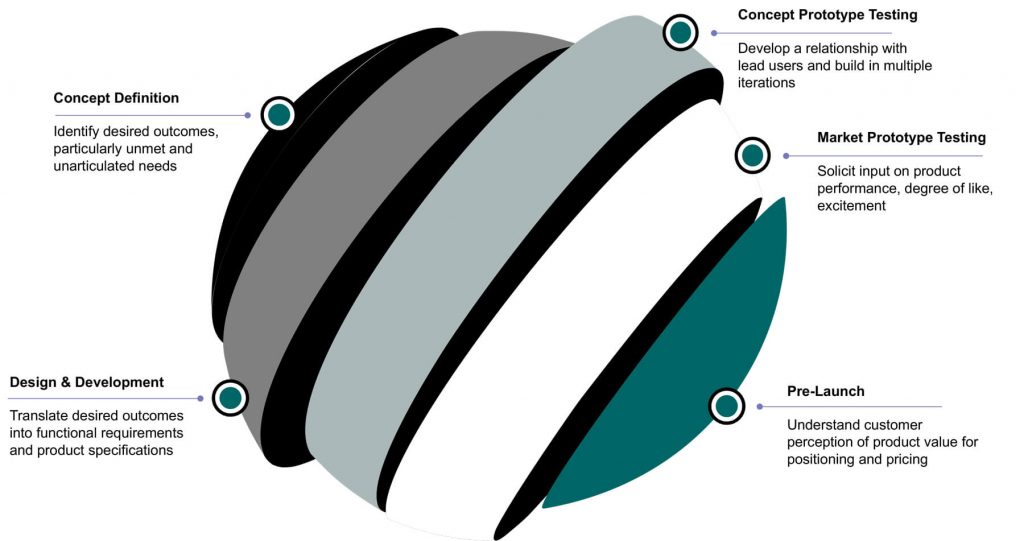The age-old view that if you build it they’ll come is rarely successful. But neither is the concept of asking customers what they want. If they knew the answer, they would have figured out the innovation themselves. In reality, customers don’t know what they are looking for until they see it.
Another school of thought prescribes putting something in front of customers to gauge their reaction and then build it. But that can result in an expensive trial-and-error method. Following these scripts companies often gamble on markets that aren’t there.
A more effective approach is to know what customer inputs truly work and incorporating these into the innovation from concept to launch. This practice will dramatically improve every aspect of the innovation process and the likelihood of success.
CUSTOMER INPUTS
Most customers are not very good at describing exactly the features they want but are quite good at articulating the underlying wants and needs and the problems they encounter with today’s products and services. Understanding this reality makes a big difference in how to approach innovation and the ultimate market results.
Getting the right customer input throughout the product development cycle is essential to get the product right and to aim at the right target. As the product takes shape throughout the various development stages, it goes through constant iterations to eventually get to the final product. Various customer inputs can be built into the development plan to test the product from start to finish to improve the odds of success.
Customer Input by Product Development Stage

Concept Definition: Customer input at this stage serves to define what is a winning product from the customer’s perspective. The objective is to gather a complete set of customer wants and needs. These include outcomes that the customer is trying to achieve that are otherwise not available, as well as constraints that may hinder adoption of the new product. Probes include desired outcomes, unmet needs, wants, wishes, choice criteria, likes, and dislikes. Powerful techniques employed here include Outcome Driven Innovation and ethnography.
Design & Development: The purpose of customer input here is to translate the customer requirements – desired outcomes for a given new product or platform – into features, attributes, and product requirements. Customer research methods include focus groups, face-to-face interviews, and in-depth market research. Because some desired outcomes rare more important than others, teams can use opportunity scoring or Kano surveys to prioritize requirements: “must,” “adds value,” “delighter,” or “indifferent.” Furthermore, a couple of techniques can help to translate customer requirements into functional requirements and product specifications. They include Quality Function Deployment (QFD) and the House of Quality.
Concept Prototype Testing: At this stage, lead users can provide valuable input. Lead users are far ahead of the industry and have a thorough understanding of future needs. The goal here is to connect with lead users and work with them to assess customer acceptance. Not only they can test the proposed product, often they provide solutions. So, it’s important to let them look, touch, feel and try the product, and use the findings to gauge interest, degree of liking, perceived value, preferences, and purchase intent.
Market Prototype Testing: By this stage the product has been partially proven. The purpose is to provide final testing and complete validation of the commercial product, its production, and marketing. By now the product must work right not only in the lab, but it must also work right when the customer uses it. Beyond functional performance, the product must excite and delight the customer. Potential customers must find the new product not only acceptable but like it better than what they use currently. Customer input at this stage comes from preference tests, extended trials, field trials or beta tests.
Pre-Launch: In preparing for launch, understanding the customer perception of product value is essential for product positioning, messaging, and pricing. Product positioning refers to how potential customers perceive the product versus competitive products. Pricing is difficult to generalize, but ultimately it requires a clear understanding of the product’s value to the customer. Therefore, customer input is necessary in both cases. Valuable customer research includes measuring intent to purchase and product value, trade-off analysis of price features and attributes, and trial selling.
BENEFITS
Leading innovators like HP, Microsoft, Johnson & Johnson, Pfizer, Bosch and many others recognize the challenge of getting the right customer input. Customers don’t necessarily know what product they want, but they know what outcomes they desire. Taking advantage of this reality makes a big difference in how to approach innovation and the ultimate market results.
By standardizing the collection and use of the right customer inputs, leading innovators can move from a guessing game to a concrete discipline and a predictable informed process that build on customer value every step of the way. Various customer inputs can be built into the development plan to test and shape the innovation from start to finish, and thereby improve the odds of success.
Citations
- Anthony W. Ulwick “What Customers Want: Using Outcome-Drive Innovation to Create Breakthrough Products and Services,” McGraw-Hill, 2005, New York, NY
- Robert G. Cooper “Winning at New Products” Perseus Publishing, 2001, Cambridge, MA
- Paul Belliveau, Abbie Griffin, Stephen Somermeyer “The PDMA Handbook for New Product Development,” John Wiley & Sons, 2004, Hoboken, NJ

